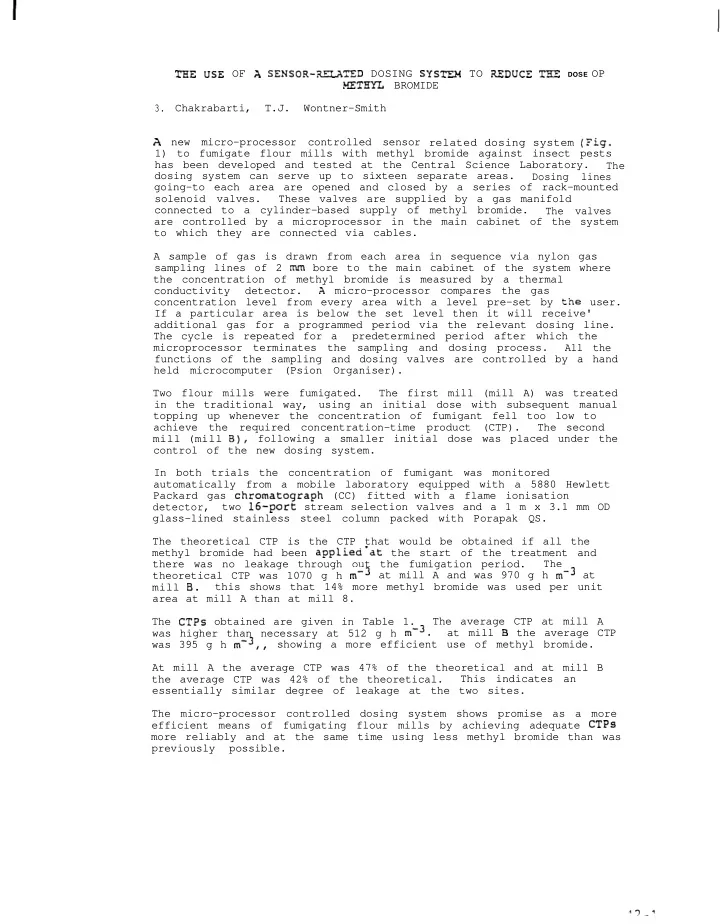

I'-BB USE OF X SENSOR-=TED DOSING SYSTBZ4 TO REDUCE TBB DOSE OP .KETHY?L BROMIDE Chakrabarti, T.J. Wontner-Smith 3. A new micro-processor controlled sensor related dosing system (Fig. 1) to fumigate flour mills with methyl bromide against insect pests has been developed and tested at the Central Science Laboratory. The dosing system can serve up to sixteen separate areas. Dosing lines going-to each area are opened and closed by a series of rack-mounted solenoid valves. These valves are supplied by a gas manifold connected to a cylinder-based supply of methyl bromide. The valves are controlled by a microprocessor in the main cabinet of the system to which they are connected via cables. A sample of gas is drawn from each area in sequence via nylon gas sampling lines of 2 mm bore to the main cabinet of the system where the concentration of methyl bromide is measured by a thermal X micro-processor compares the gas conductivity detector. concentration level from every area with a level pre-set by t'he user. If a particular area is below the set level then it will receive' additional gas for a programmed period via the relevant dosing line. The cycle is repeated for a predetermined period after which the microprocessor terminates the sampling and dosing process. All the functions of the sampling and dosing valves are controlled by a hand held microcomputer (Psion Organiser). Two flour mills were fumigated. The first mill (mill A) was treated in the traditional way, using an initial dose with subsequent manual topping up whenever the concentration of fumigant fell too low to achieve the required concentration-time product (CTP). The second mill (mill B), following a smaller initial dose was placed under the control of the new dosing system. In both trials the concentration of fumigant was monitored automatically from a mobile laboratory equipped with a 5880 Hewlett Packard gas chromatograph (CC) fitted with a flame ionisation detector, two 16-port stream selection valves and a 1 m x 3.1 mm OD glass-lined stainless steel column packed with Porapak QS. The theoretical CTP is the CTP that would be obtained if all the methyl bromide had been applied-at the start of the treatment and The there was no leakage through out the fumigation period. at mill A and was 970 g h me3 at theoretical CTP was 1070 g h mV3 this shows that 14% more methyl bromide was used per unit mill B. area at mill A than at mill 8. The CTPs obtained are given in Table 1. The average CTP at mill A at mill B the average CTP was higher than necessary at 512 g h mm3. was 395 g h m-j,, showing a more efficient use of methyl bromide. At mill A the average CTP was 47% of the theoretical and at mill B the average CTP was 42% of the theoretical. This indicates an essentially similar degree of leakage at the two sites. The micro-processor controlled dosing system shows promise as a more efficient means of fumigating flour mills by achieving adequate CTPS more reliably and at the same time using less methyl bromide than was previously possible.
Concentration- Tine Products (CTFS) of methyl bromide Table 1. obtained at Mill X and Mill B. CTPs obtained at various positions (g h nq3) -_ Floor Mill A Mill B Ground 723 441 533 514 781 1 614 358 367 440 437 2 411 308 305 379 376 3 .388 321 330 345 343 4 442 235 496 302 Average 512 395 4 2 - 2
0 0 - - ‘E 2 \ I V 4 2 - 3
Recommend
More recommend